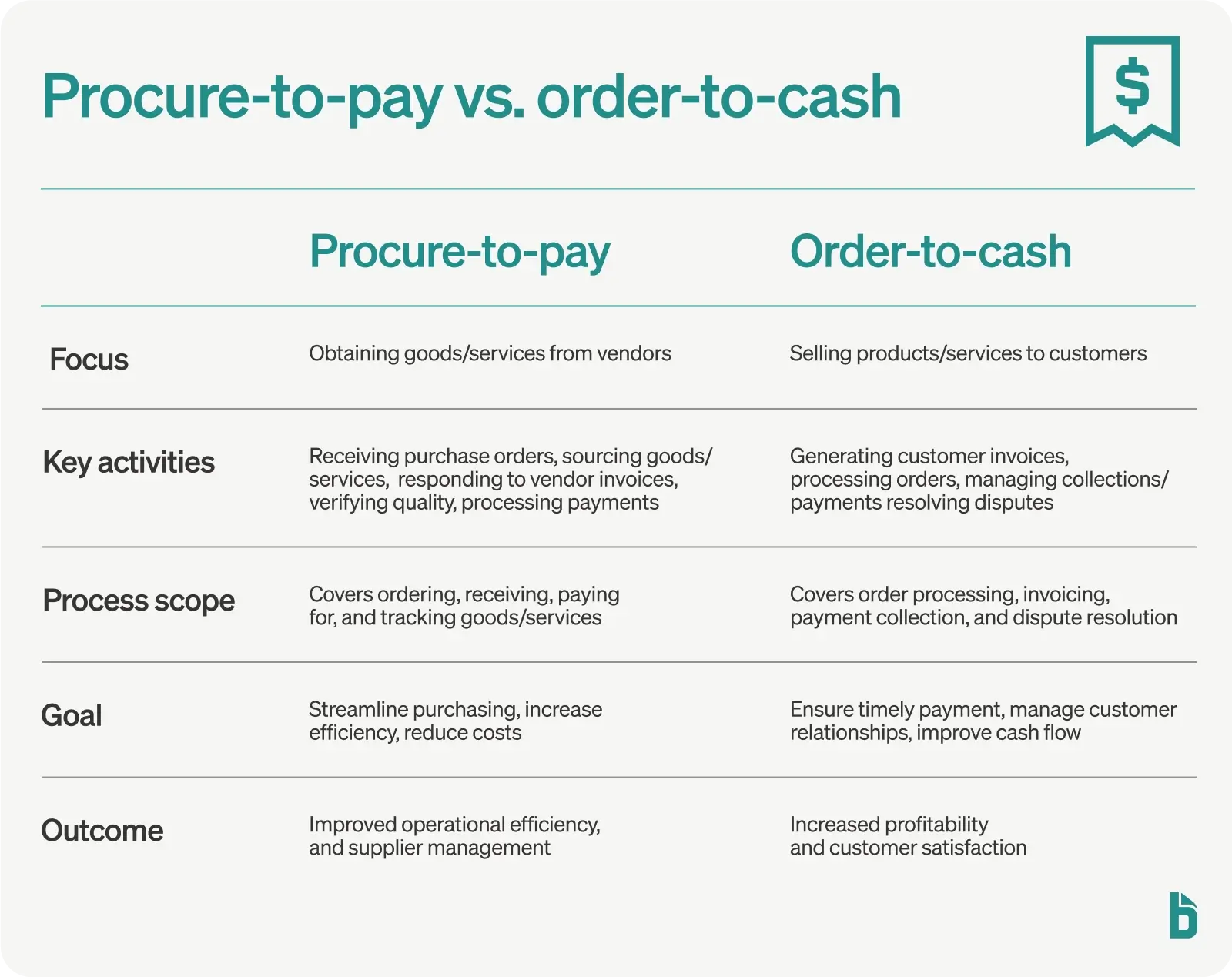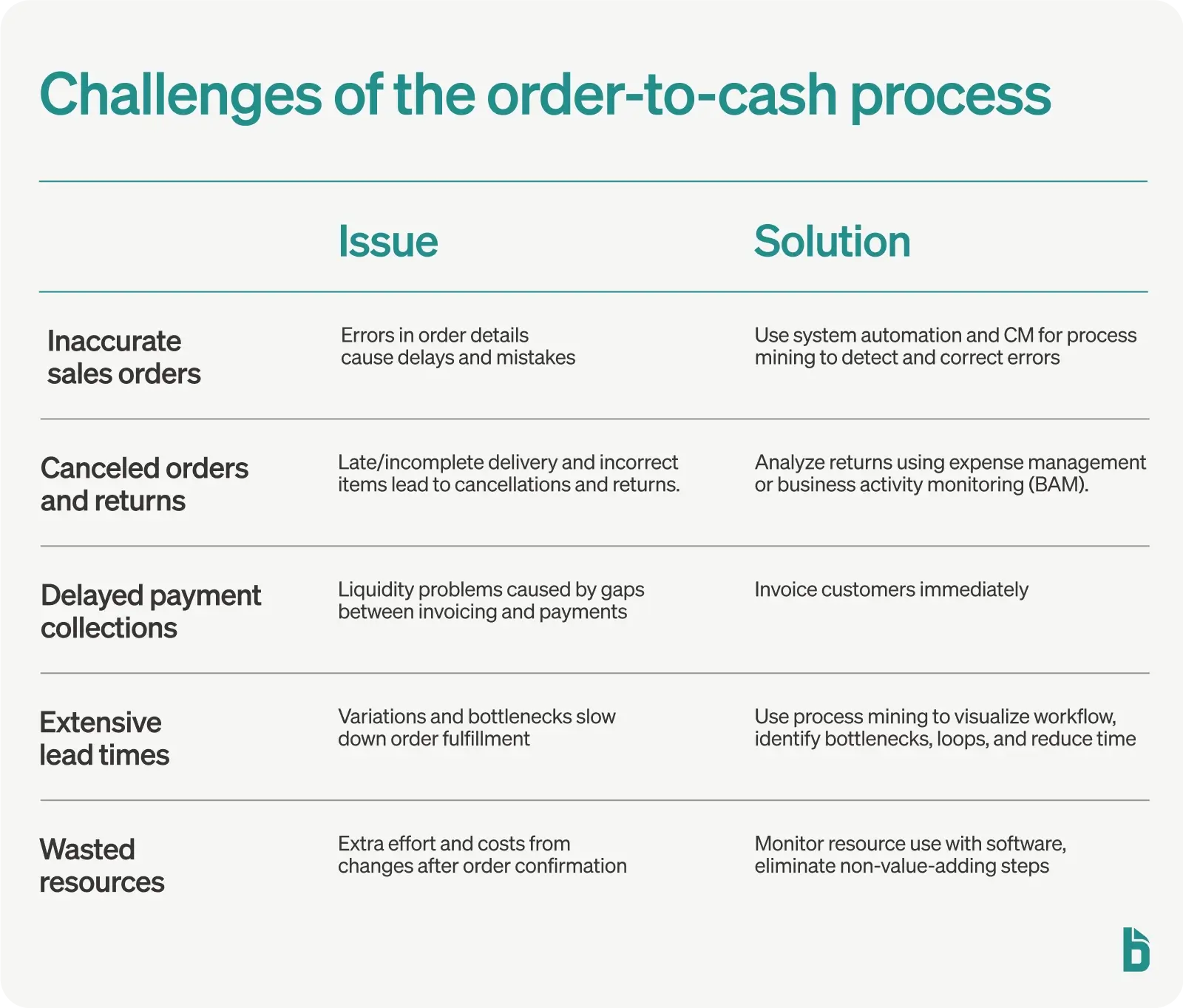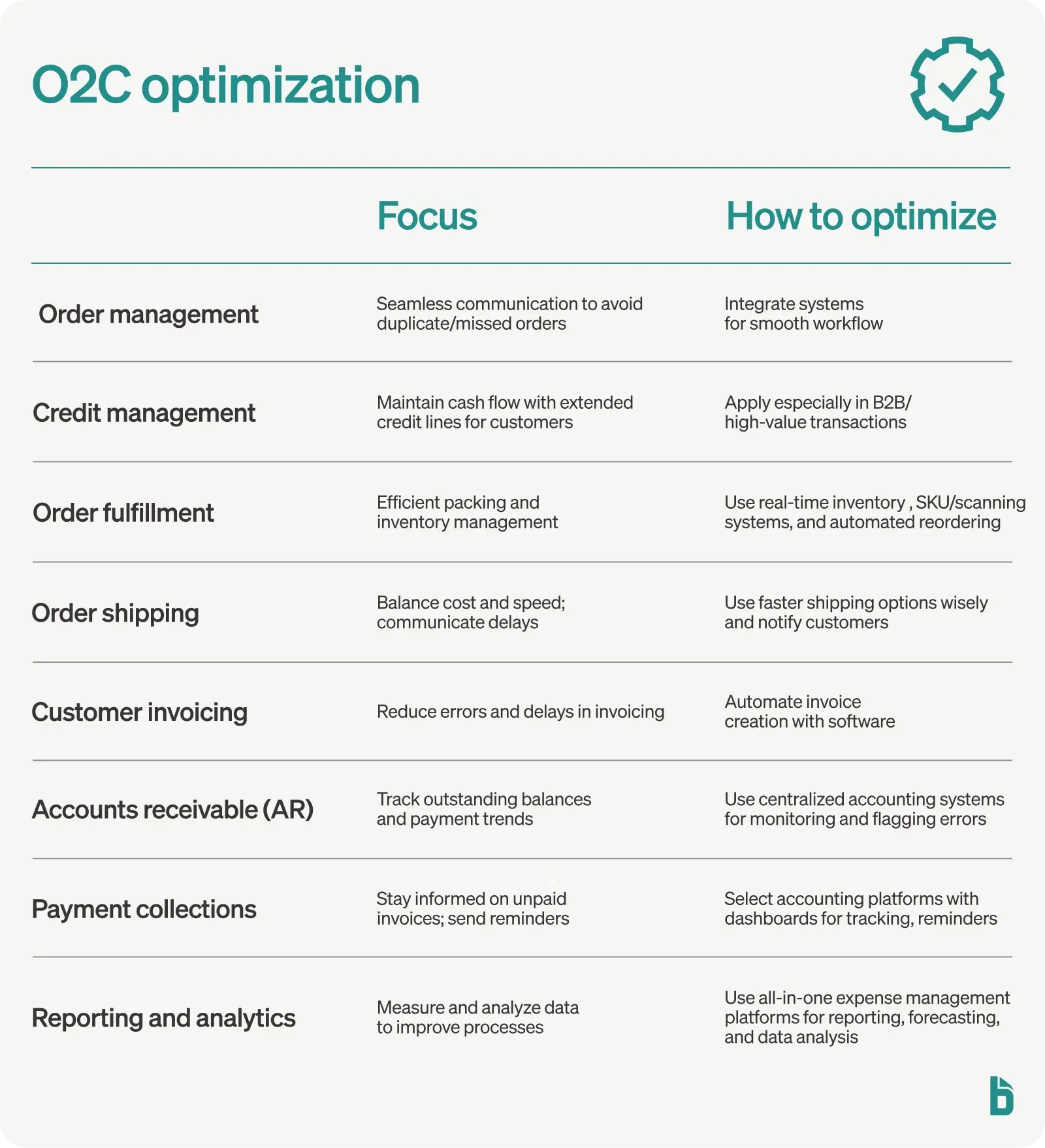As businesses rely more on an online presence and social media usage, many small business owners all over the United States are looking to increase their marketing budgets.
With a rise in funds and resources allocated to marketing budgets alone, business owners hope to increase branding, attract more leads, and convert views into sales.
That’s where the order-to-cash process (O2C) comes into play. This process directly impacts customer satisfaction, the supply chain, and inventory management.
What is the order-to-cash process — and why is it important?
The O2C process encompasses all aspects of a sale, including collecting payment, shipping items, creating invoices, and archiving transactions for data reference.
And yet, the importance of the order-to-cash process is often taken for granted.
But O2C is essential because it influences your revenue, customer retention rates, interaction levels, and company growth through various streamlined processes, such as:
- Reduced order-to-fulfillment time for your customers
- The buying process is streamlined for customers
- Avoiding backorders
- Accurately fulfilling orders the first time around
- Demonstrates brand reliability and professionalism
- Decreases the need for customer support from representatives
- Enhances your accuracy of records and data reporting
Now that you understand the importance of relying on a basic O2C process, let’s delve into the specific steps.

Procure-to-pay vs. order-to-cash: What’s the difference?
The primary difference between procure-to-pay (P2P) and order-to-cash (O2C) is the focus of each process.
The P2P process focuses on procedures related to obtaining goods/services from vendors, while the O2C process handles activities associated with selling products/services to customers.
In the P2P process, activities include:
- Receiving purchase order (PO) from customer or internal department
- Sourcing for goods/services at lowest total cost of ownership
- Responding to vendor invoices and queries
- Verifying quality of goods against PO specifications and payment terms
In the O2C, activities include:
- Generating customer invoices and terms of payment
- Processing customer orders and related documentation such as order acknowledgements, shipping contracts, and credit memos
- Managing customer collections/payments
- Resolving any disputes or discrepancies with customers
Overall, the procure-to-pay process is focused on purchasing from suppliers and selling to customers. It covers the entire process of ordering, receiving, paying for, and tracking goods or services. By having a thorough understanding of the procure-to-pay process, organizations are able to streamline their operations, increase efficiency, and reduce costs. This ultimately leads to increased profitability and customer satisfaction.
How to conduct a successful order-to-cash process
The ordering processing system kicks in when a customer makes an order. All steps that precede that moment have to do with marketing, sales, or branding.
So, what is the order-to-cash cycle?

It’s how your business will receive, process, manage, and complete a customer’s order. You don’t need automated software to do this, but a company must develop a baseline understanding of the process to optimize it.
Step #1: Order management
Once the customer’s purchase gets confirmed, companies are strictly responsible for management actions.
To stay ahead of the action, you have to automate your order management system. Notifications should be sent to all departments as soon as a purchase occurs.
The accuracy of an order is perhaps the most important. If you have an error at the initial order verification point, it can mess up the entire process.
Step #2: Credit management
Credit management is integral because it evaluates a customer’s financial health to decide whether or not to extend business credit approval.
The process starts with ensuring that potential customers are creditworthy and financially competent to reduce the risk of late payment or default.
Step #3: Fulfillment
Here’s where the order is prepped for shipment or the appointment for a service gets scheduled. By automating your business processes, the shipping or service department remains in the know about an order’s status and stage in the process.
Proper supply chain management ensures that your inventory is kept current and accurate, so your customers never have to wait for their orders to get filled.
If an item is out-of-stock, this should be an automatic red flag. Your system should notify the customer immediately and let them cancel or wait.
Step #4: Shipping
Logistics is a significant step in the O2C cycle, requiring frequent auditing to ensure high-quality assurance standards.
You need an order processing system to pull data from the fulfillment stage. Each sub-step has to be accurately recorded so the shipping team can coordinate with carriers and deliver orders.
Step #5: Invoicing
The invoice records the order details such as shipping and billing contacts, description of services or goods provided, and cost of items, including fees and taxes.
Invoices can be sent by email or printed and mailed by an internal department or a third-party vendor.
Step #6: Accounts receivable (AR)
After a product is sold and shipped, the accounts receivable process begins. It includes invoice generation and delivery, reconciliation, and tracking of payments against the ledger.
An outstanding accounts receivable team automates payment reminders before the invoices are due. The AR team is responsible for investigating and solving invoicing errors and reissuing invoices if mistakes occur.
Step #7: Payment collections
The first step to collecting and monitoring payments is to have a notification system to alert you of any customer payments.
You can encounter urgent customer satisfaction issues if the customer feels annoyed by an inaccurate payment collection request, so ensure that the payment process system properly marks orders as paid.
Step #8: Data Management and reporting
The best way to optimize O2C is with high-end software to generate reports.
It’s critical to analyze and observe the customer journey from purchasing the product until receiving it. Use these metrics to determine if things are going smoothly.

Challenges of the order-to-cash process and how to solve them
As with many business processes, some challenges may require creative problem-solving.
Regarding the order-to-cash process flow, the best way to navigate this cycle is to navigate challenges and have readymade solutions.
Some things to watch out for are:
- Inaccurate sales orders
- Canceled orders and returned goods
- Payment collections
- Extensive lead times
- Wasted resources
Let’s break down how these issues may arise and what you can do to address them seamlessly.
Tip #1: Ensure orders are correct and ship on time
It’s crucial to get error-free orders out on time, with the correct quantity and condition. If mistakes arise, that indicates significant errors with your O2C process.
Process mining through system automation and a CRM (customer relationship management) program can help quantify these potential triggers for delays.
Tip #2: Prevent returned goods and order cancellations
Late or incomplete delivery and incorrect items often lead to returned and order cancellations.
Using customized metrics defined through an expense management system or business activity monitoring (BAM) can help analyze scenarios to avoid future returns.
Tip #3: Avoid delayed payment collections
Your business may experience liquidity problems from exaggerated amounts from your AR department. That hampers growth by inflating the working capital requirements unnecessarily.
Solve this by invoicing customers immediately: Determine why there’s a gap between invoices and payments and automate the process through a BAM program.
Tip #4: Improve lead time
There are usually significant variations in lead times with large procedures such as orders to cash. You need to have an elaborate list of all the sub-steps and analyze them singularly.
A process mining technique can visualize the flow and identify the throughput times, loops, bottlenecks, and any exceptions that increase lead time.
Tip #5: Resource consumption optimization
It’s essential to monitor how your company utilizes human capital resources regularly. You’ll waste resources trying to make changes to an order after confirmation.
Identify steps that cause changes, and eliminate any work that doesn’t add value to the O2C process. Use an operations software program to quantify how they affect costs.

How to optimize your order-to-cash (O2C) process
Once you have familiarized yourself with every step in the order-to-cash cycle, you can begin exploring the best ways to optimize your operations.
But why optimize it — especially if it’s already working just fine? There are quite a few reasons why most businesses decide to take a second look at their automating their O2C cycle:
- You won’t be able to retain your customers if you don’t provide a positive experience
- You can save time and money by automating your systems
- You can avoid unnecessary human errors by integrating the O2C process
- Make it easier to identify problems, track analytics, meet your KPIs, and more
These all affect every aspect of your O2C process — from order management to reporting and analytics. Here’s how.
- Order management: When you examine your workflow, you need seamless communication between all the systems. Otherwise, you risk duplicate or missed orders and payments.
- Credit management: Extending your line of credit to customers can keep your cash flow buzzing. It’s most applicable to B2B transactions and businesses that sell high-value items.
- Order fulfillment: Once the payment goes through, it’s time to pack the order. Invest in real-time inventory visibility, an SKU and scanning system, and ensure your products are always in stock with automated reordering.
- Order shipping: When balancing your budget, getting the order to the customer can be tricky. You can use quicker shipping options like FedEx, but it might eat into your budget. Businesses must track and manage orders and communicate any delays to the customer.
- Customer invoicing: The best solution is eliminating manual invoice creation by using appropriate software to implement automation.
- Accounts receivable: Your AR department must track which accounts have outstanding balances and highlight various payment trends. Use high-end accounting systems to centralize and categorize to make it easy to monitor and flag mistakes.
- Payment collections: Ensure that you select an accounting management platform with a dashboard that keeps you informed about outstanding payments, sends out payment reminders, and generates invoices.
- Reporting and analytics: You need end-to-end software to measure and analyze data for short and long-term fixes. Processing the O2C cycle in an all-in-one expense management platform can help you create reports, analyze data, and make forecasts.
Choose an automated system to optimize your O2C process.
Many problems with a business’s order-to-cash process derive from manual procedures riddled with human error, like a high rate of exceptions or delayed customer deliveries and collections.
Sounds like your business? Then it’s time to optimize your O2C cycle and accounts receivable process through automation. Luckily, that’s where BILL comes in.
BILL’s automated accounts receivable software may enhance your O2C process by helping you reduce costs, improve speed, forecast cash flow, and better data management.
Learn more about how BILL can help your business save time and money.


